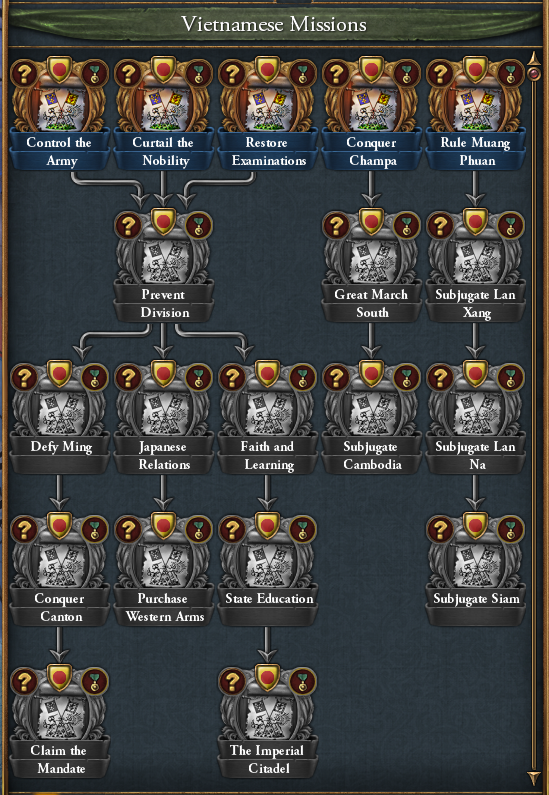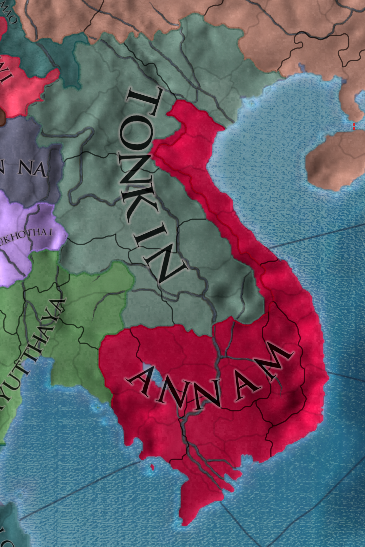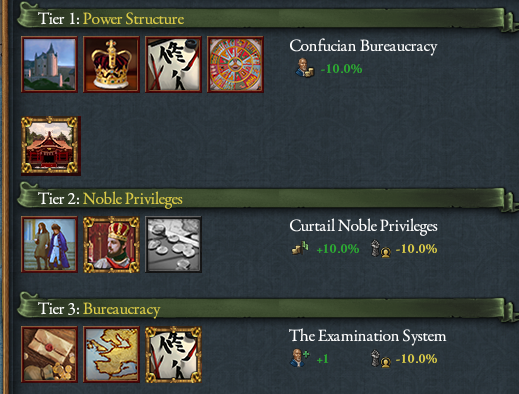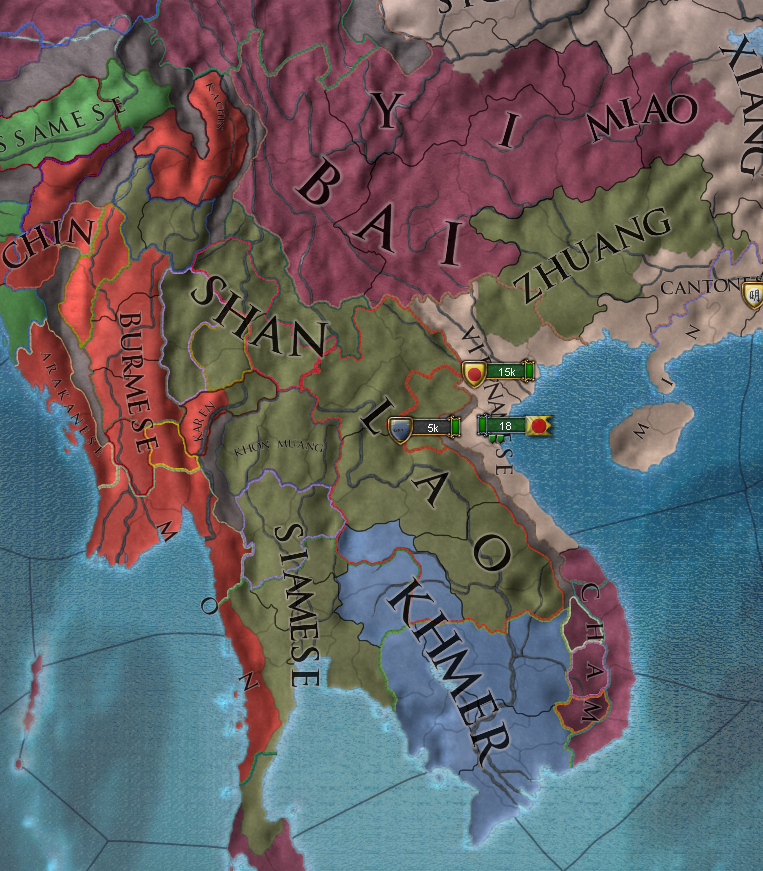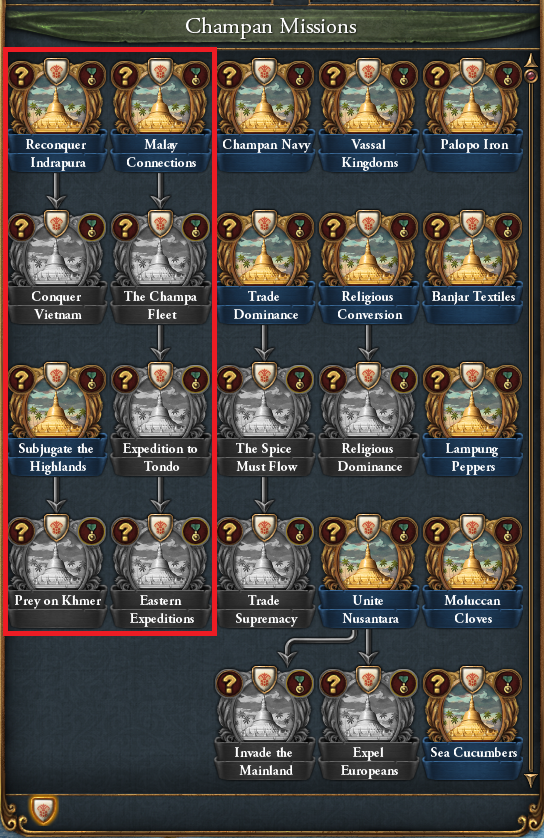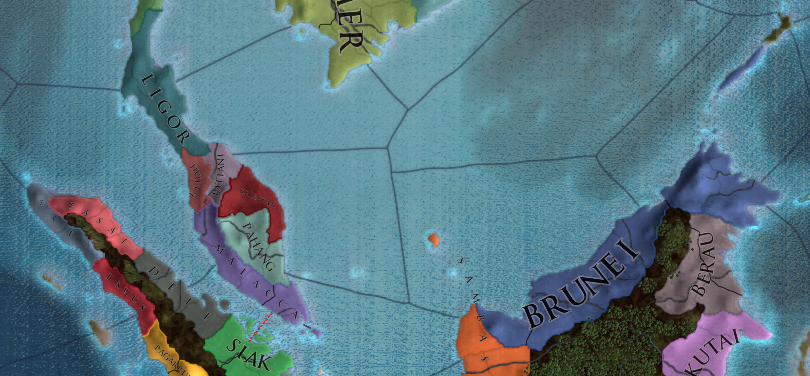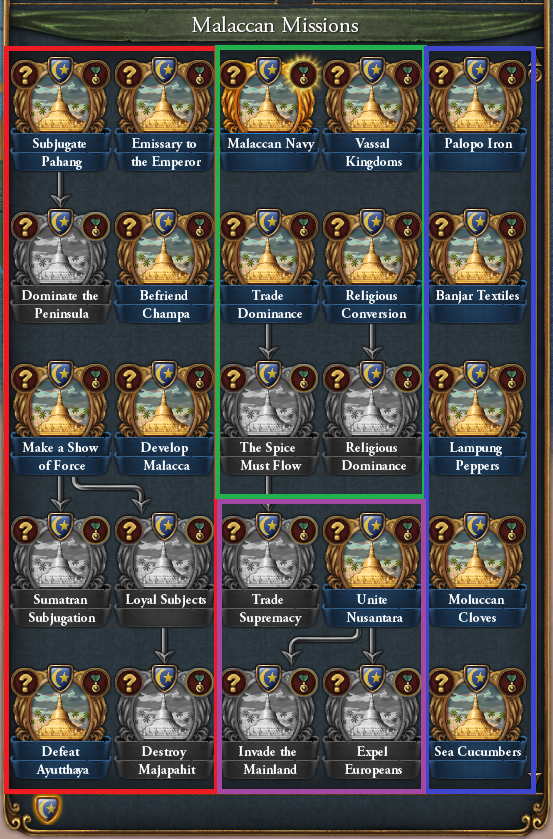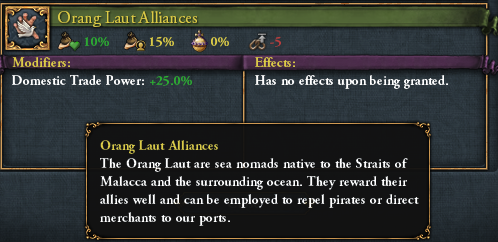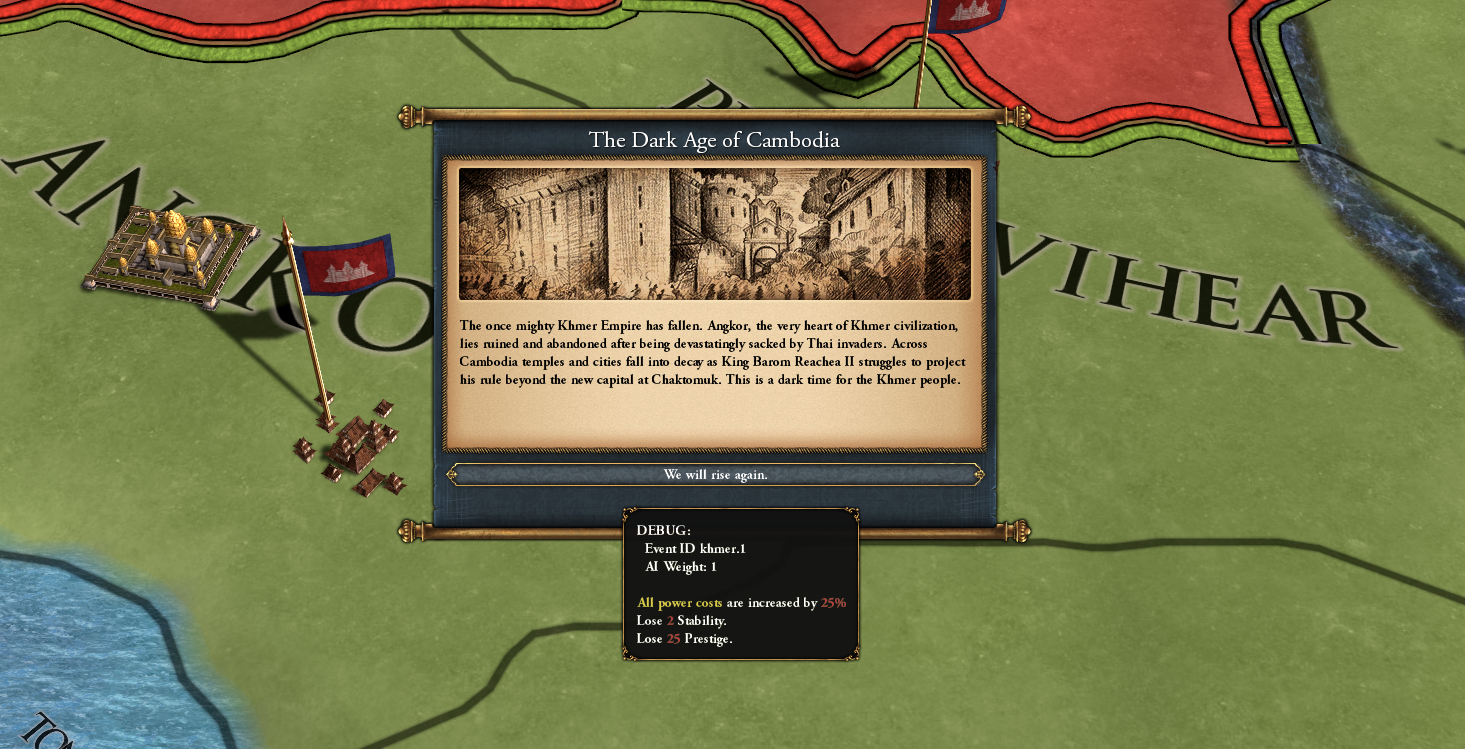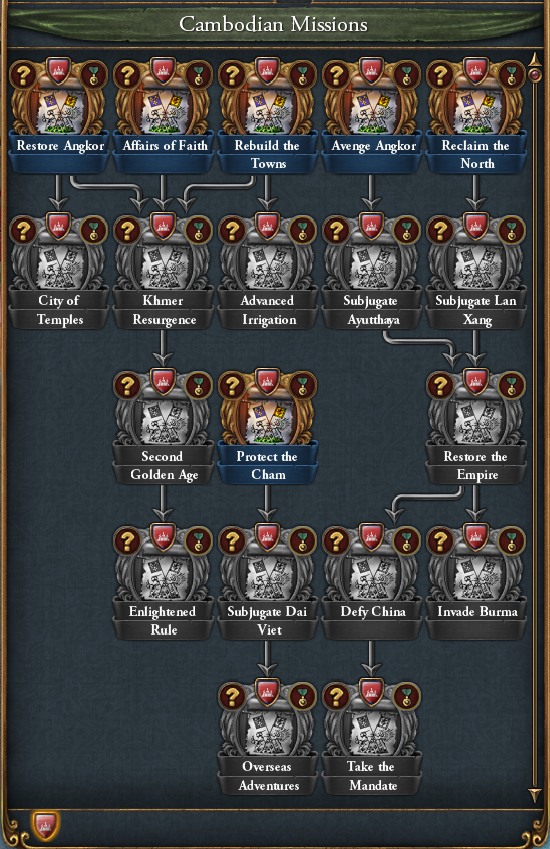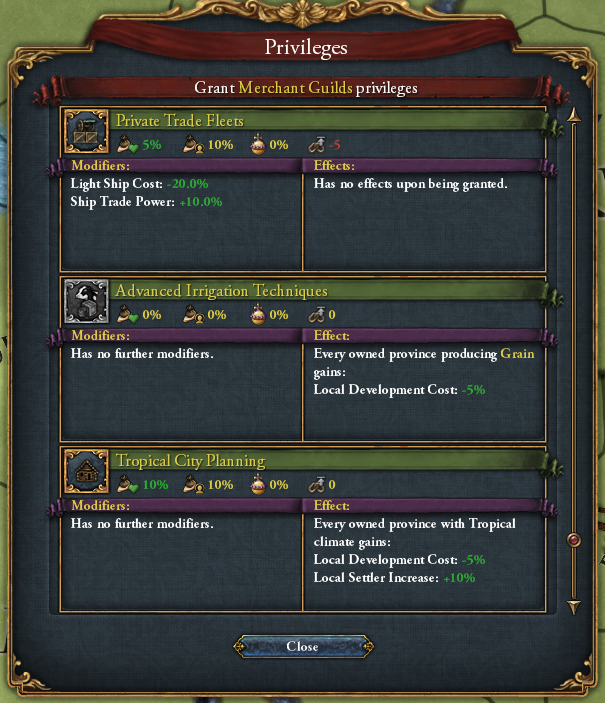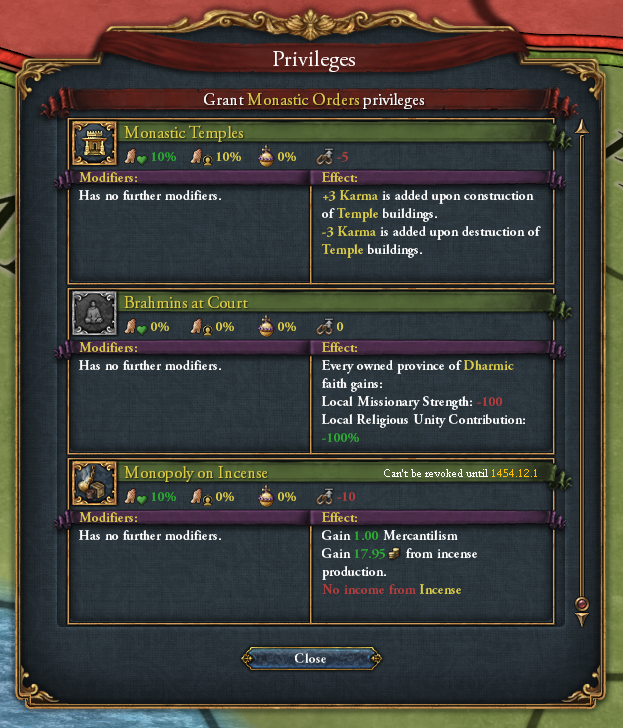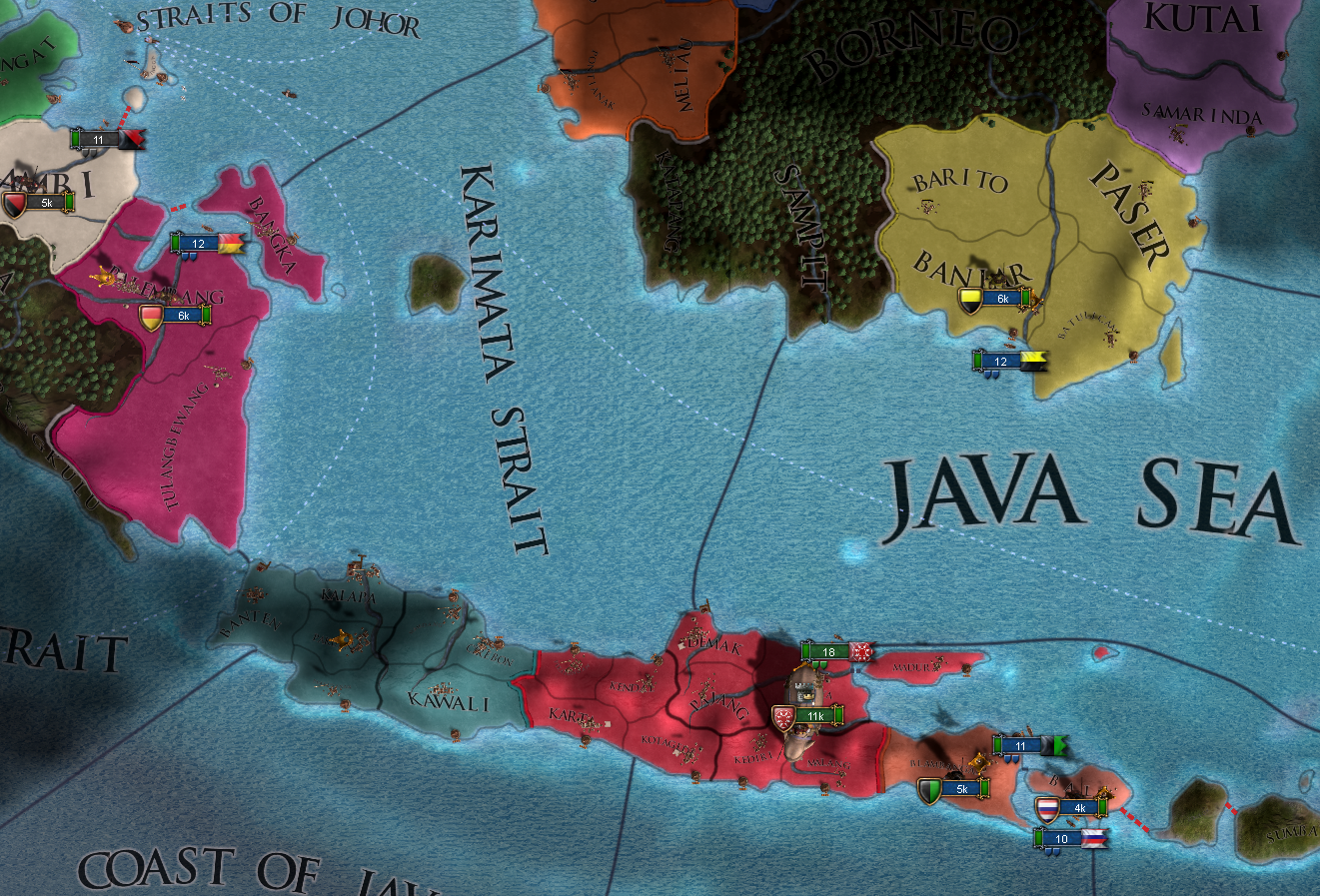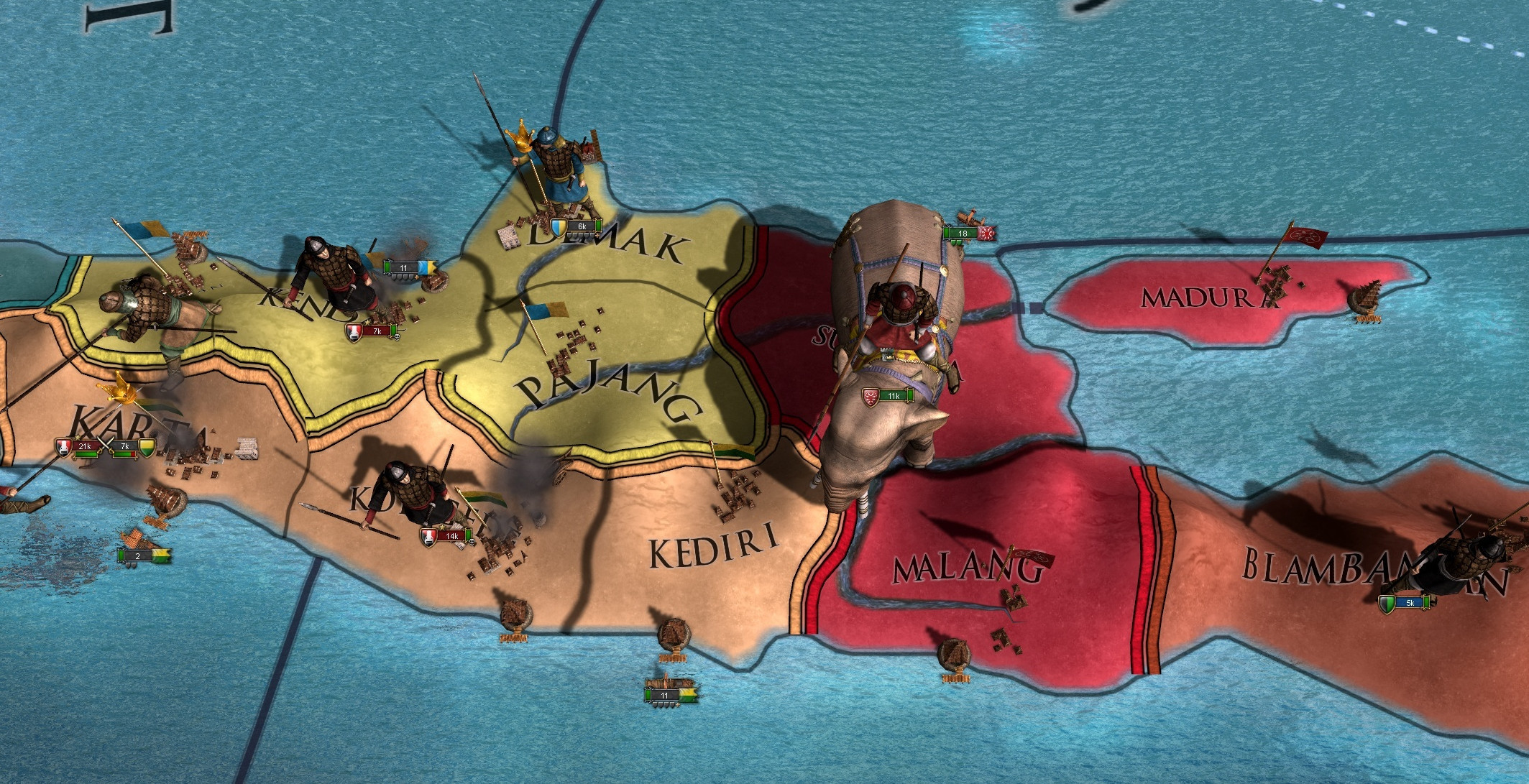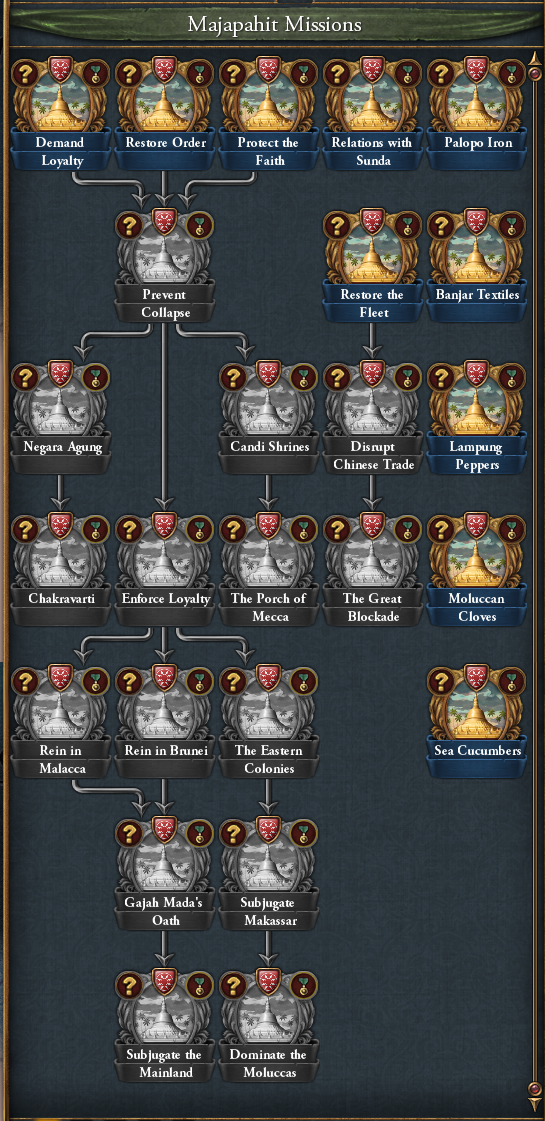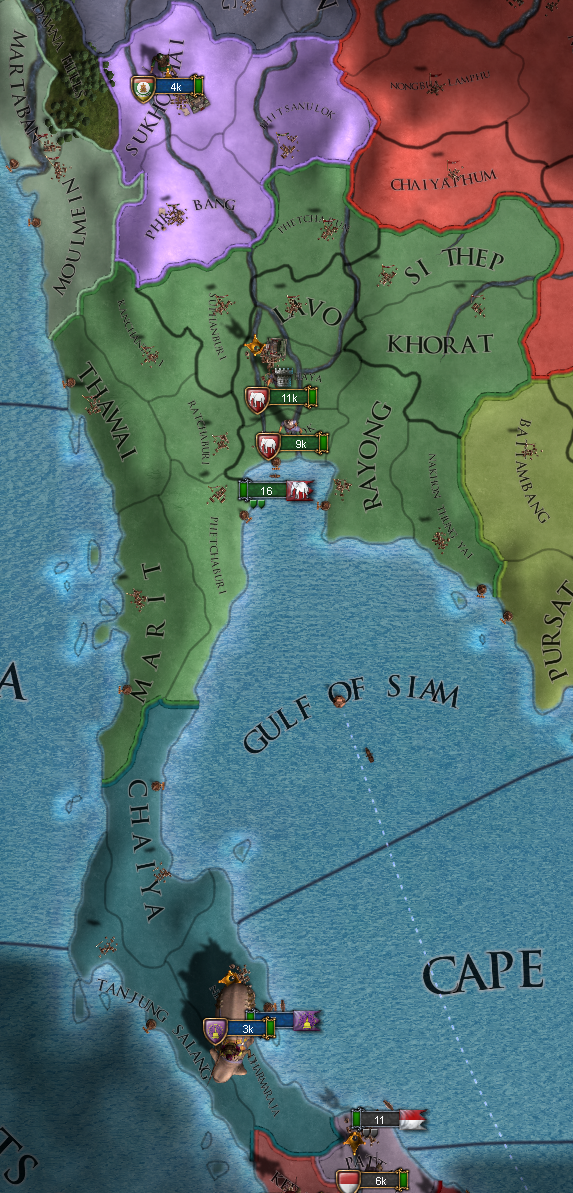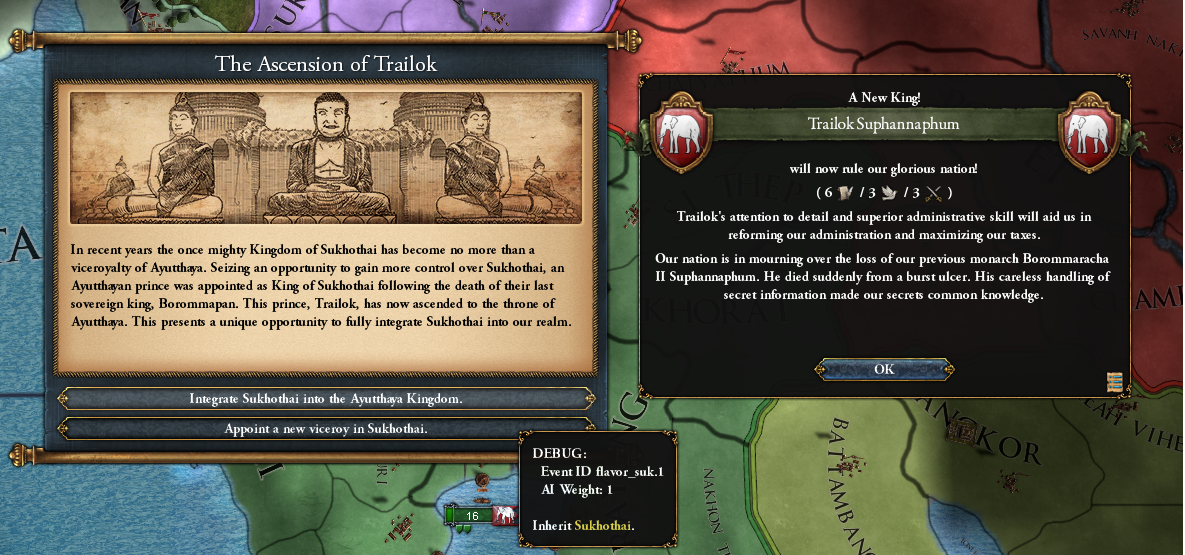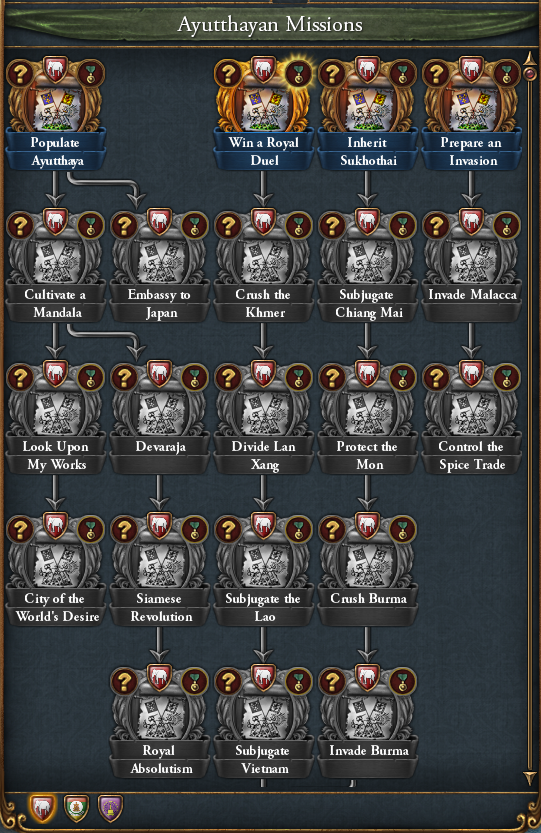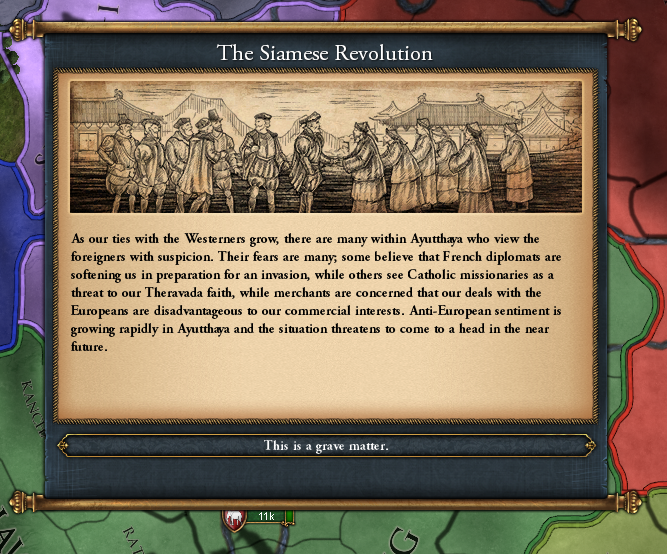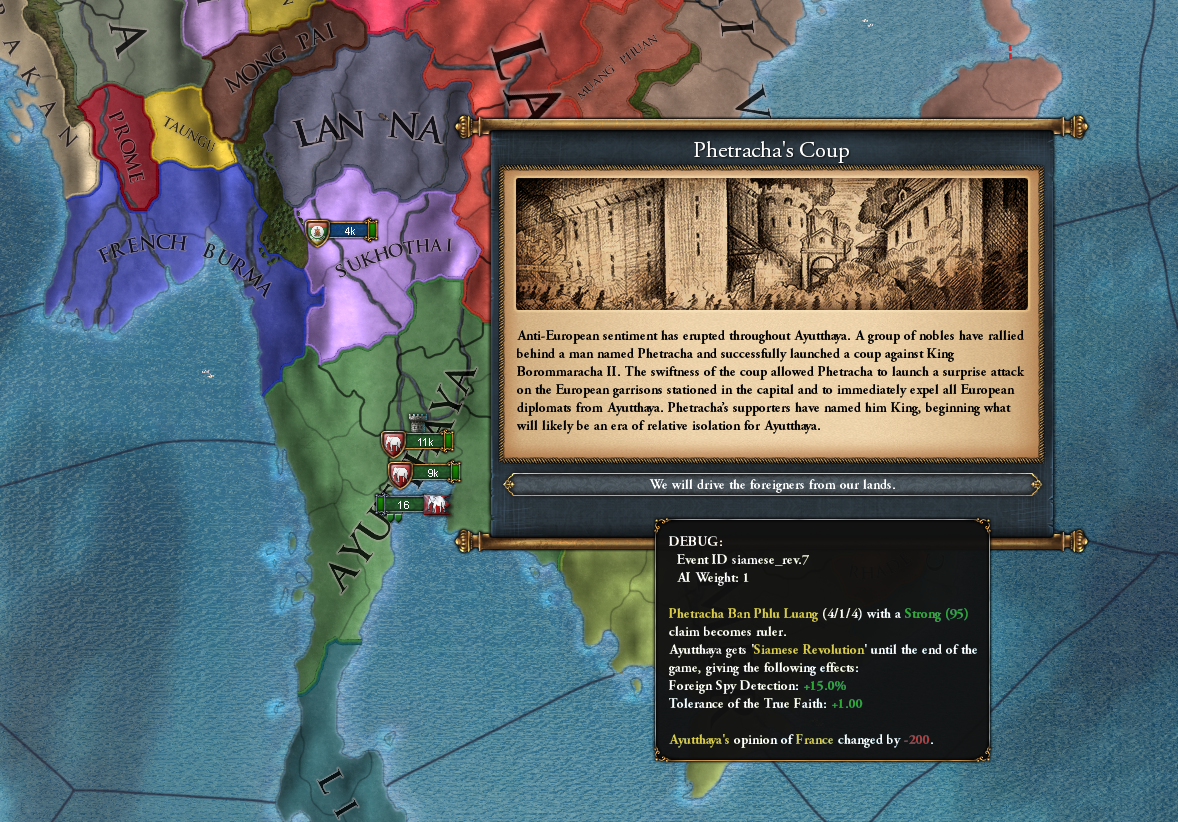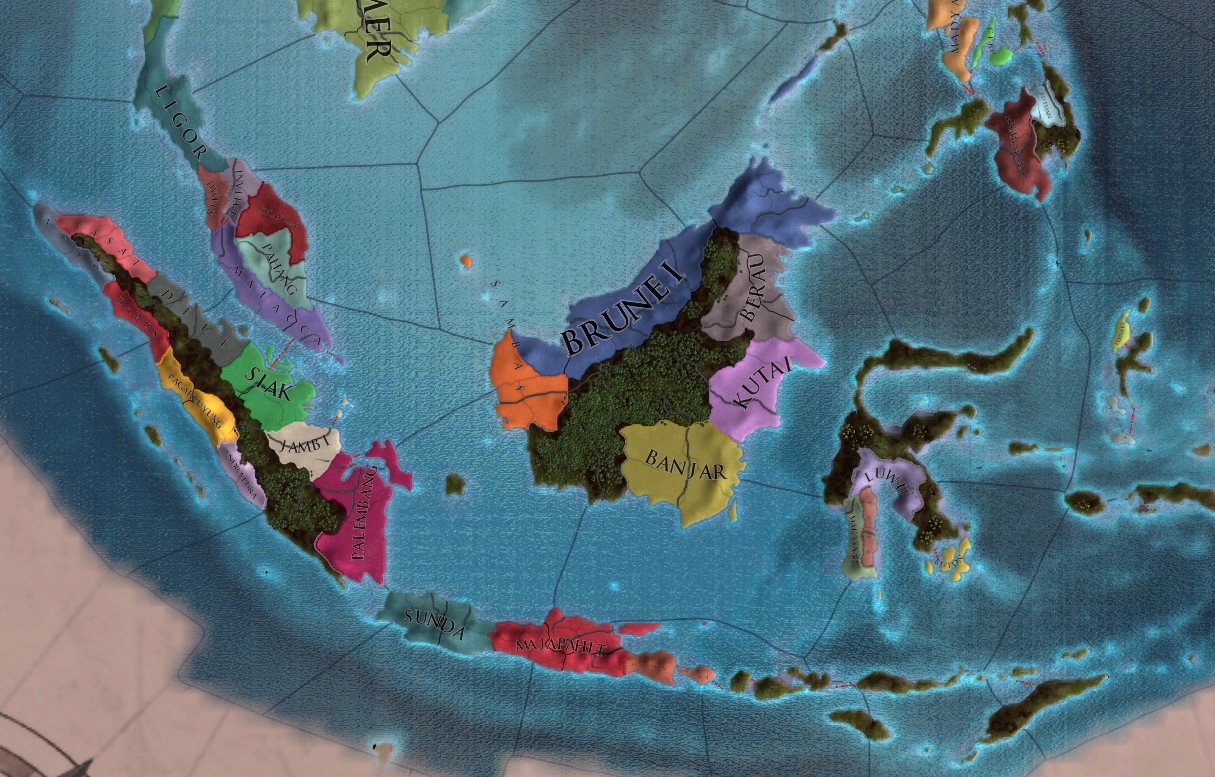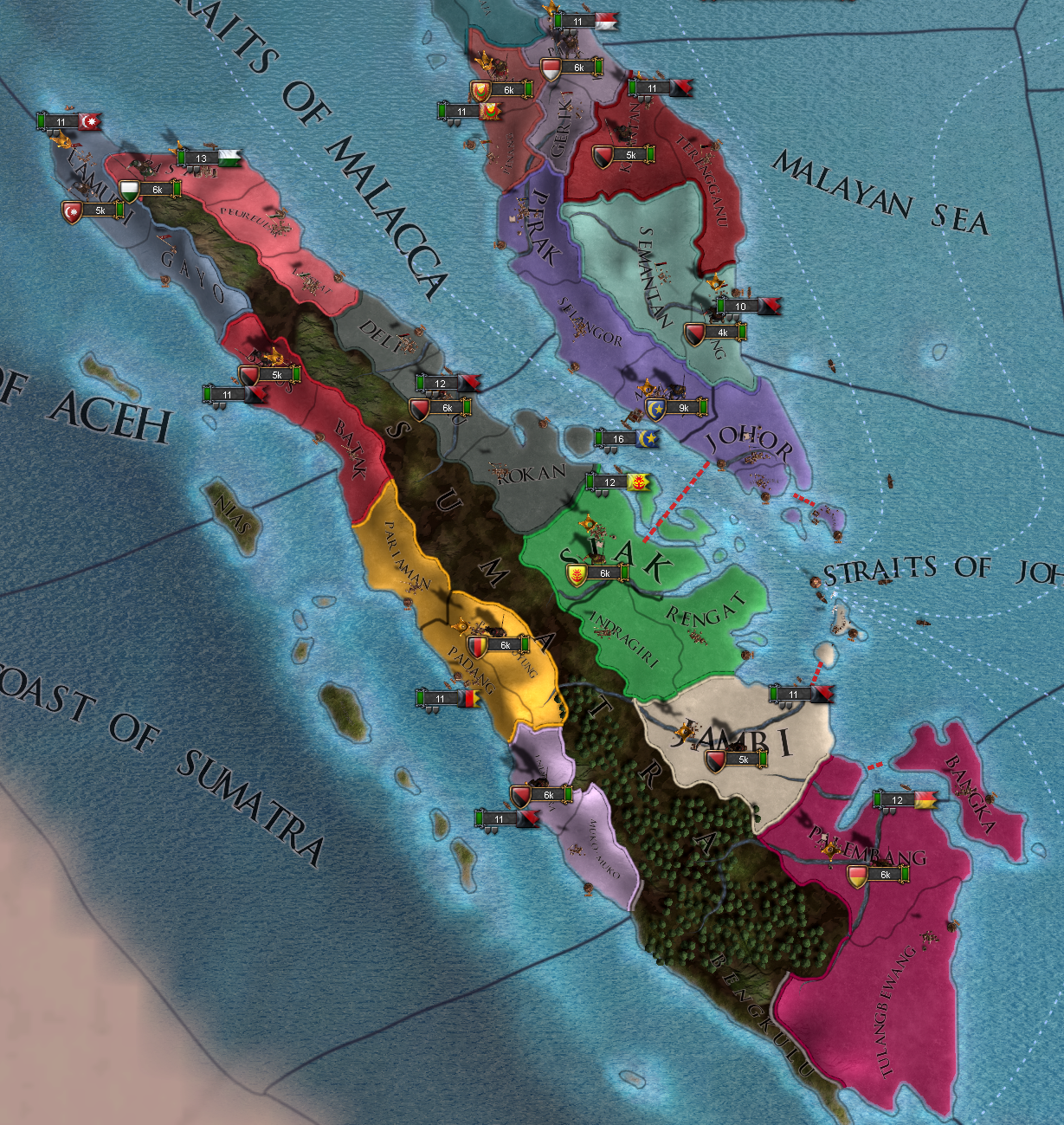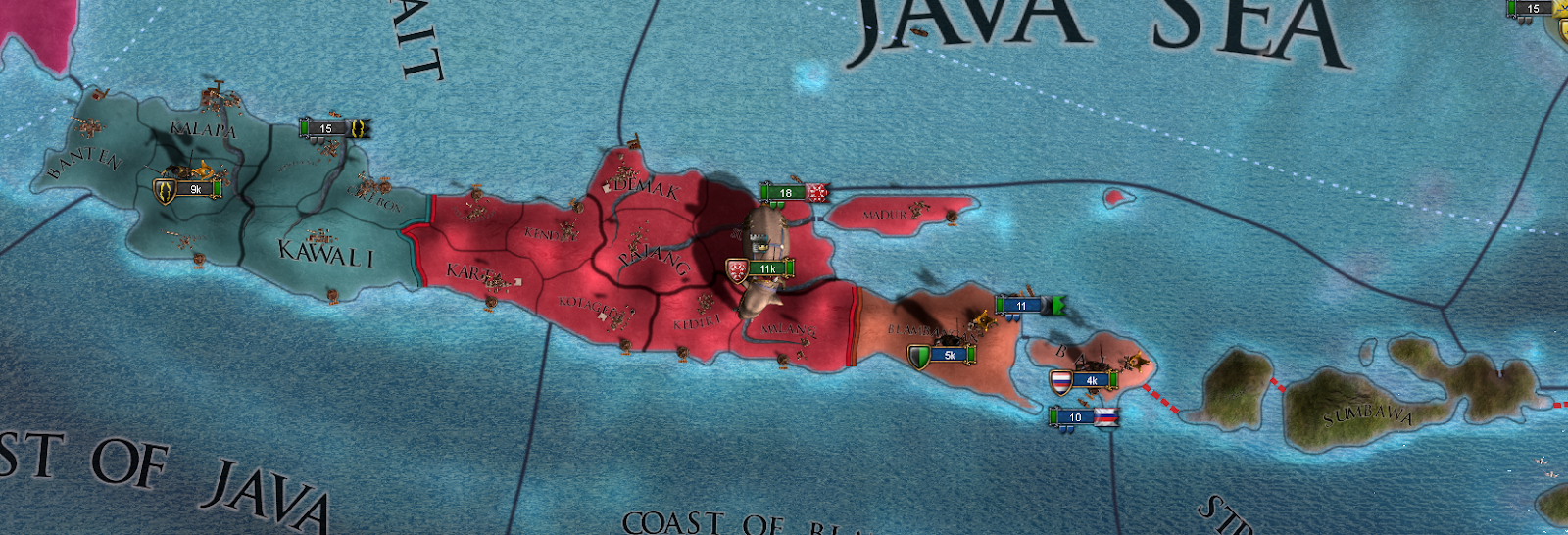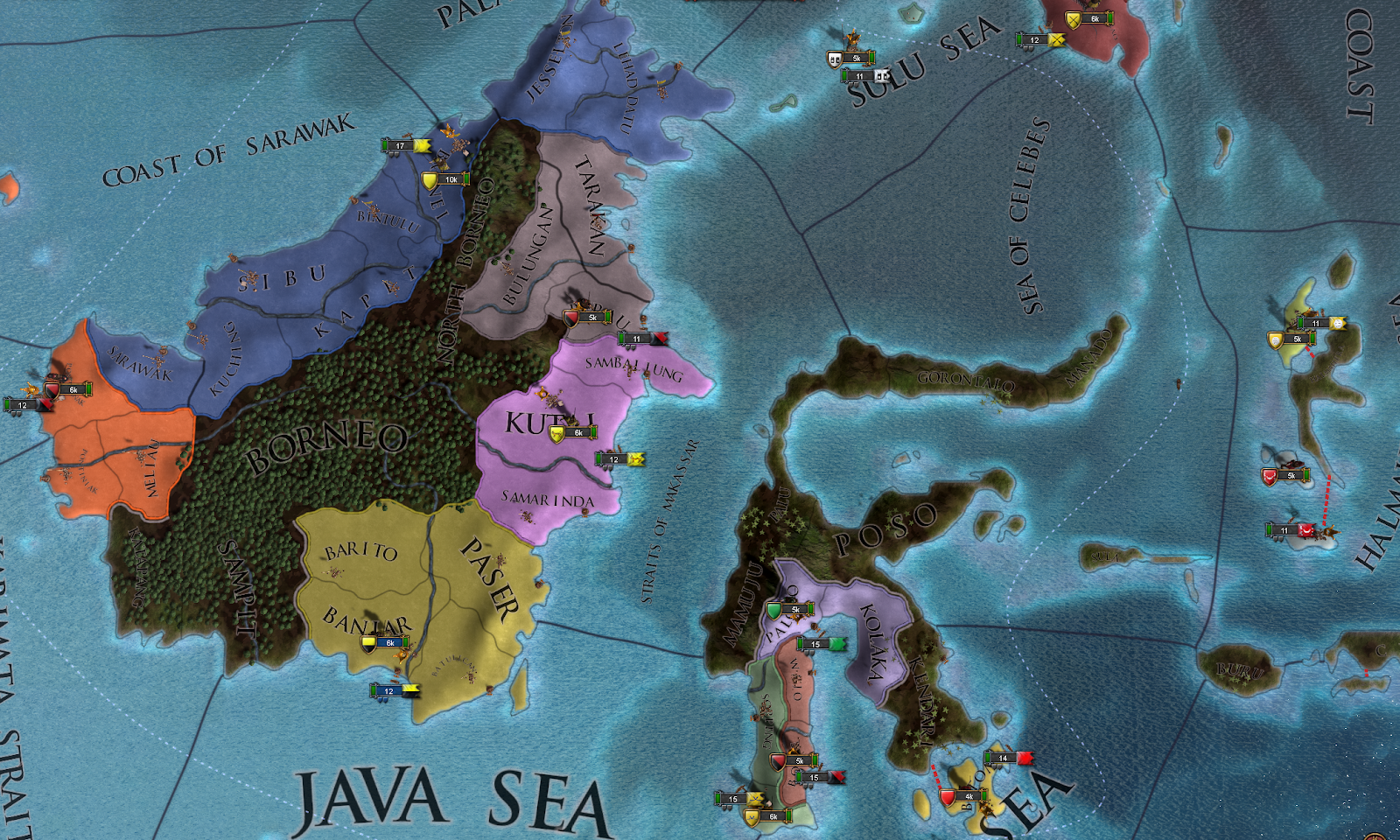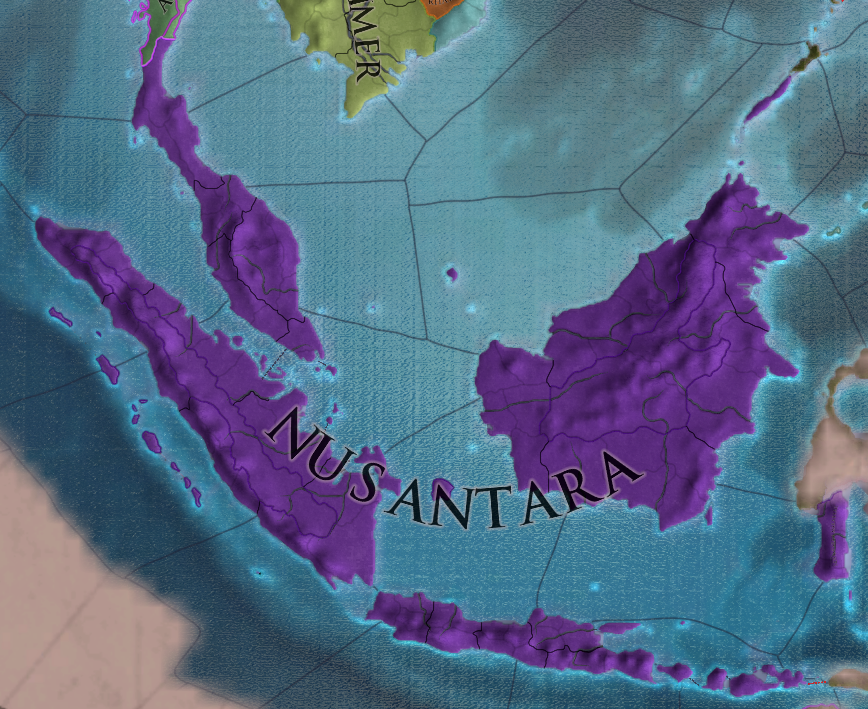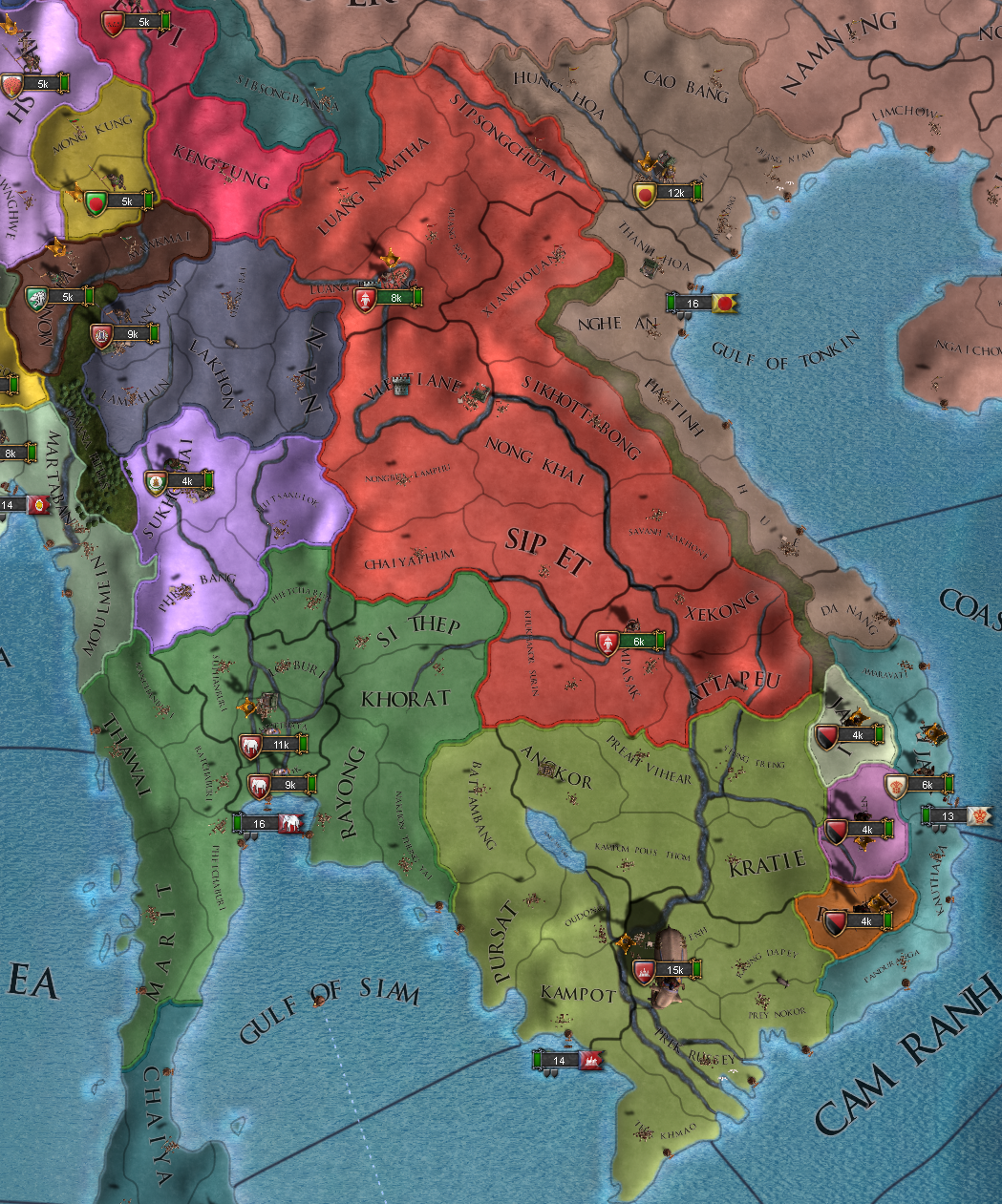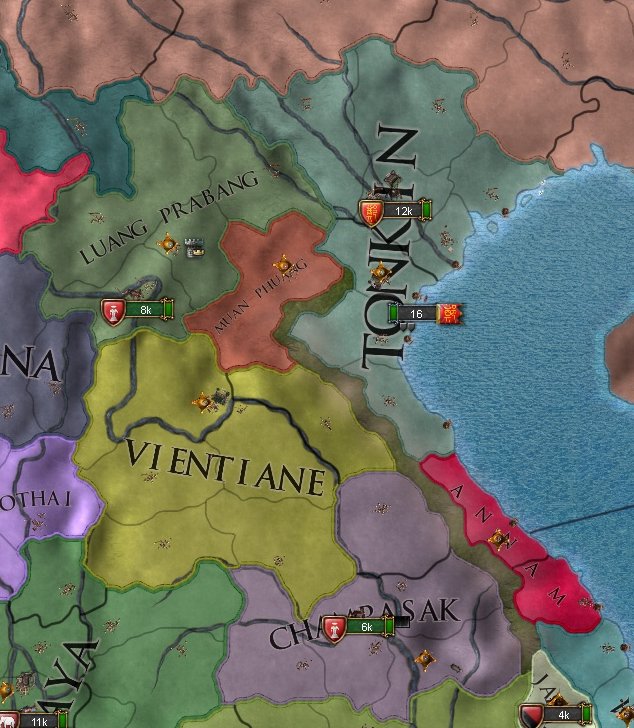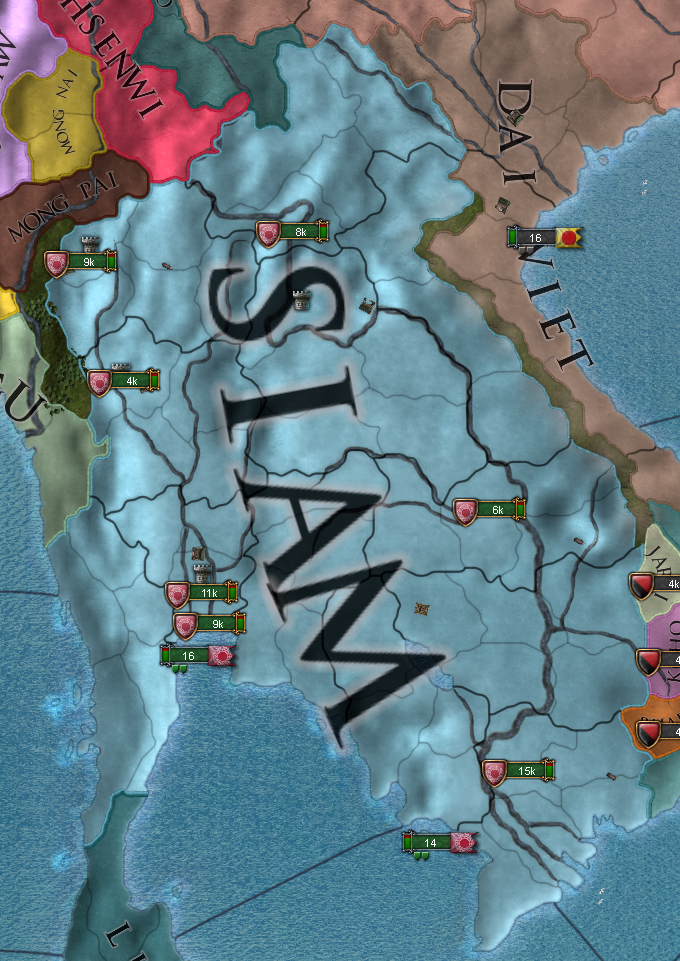
Aug 25, 2020
Europa Universalis IV - MagnusPDX
Read on the Forums
A word from PDX about the next patch
Good morning! Today’s dev diary will focus on Pegu but will also feature a variety of nations in Mainland South-East Asia - namely Lan Na, Sukhothai, the Shan states, the Burman nations, and the highland tribes.
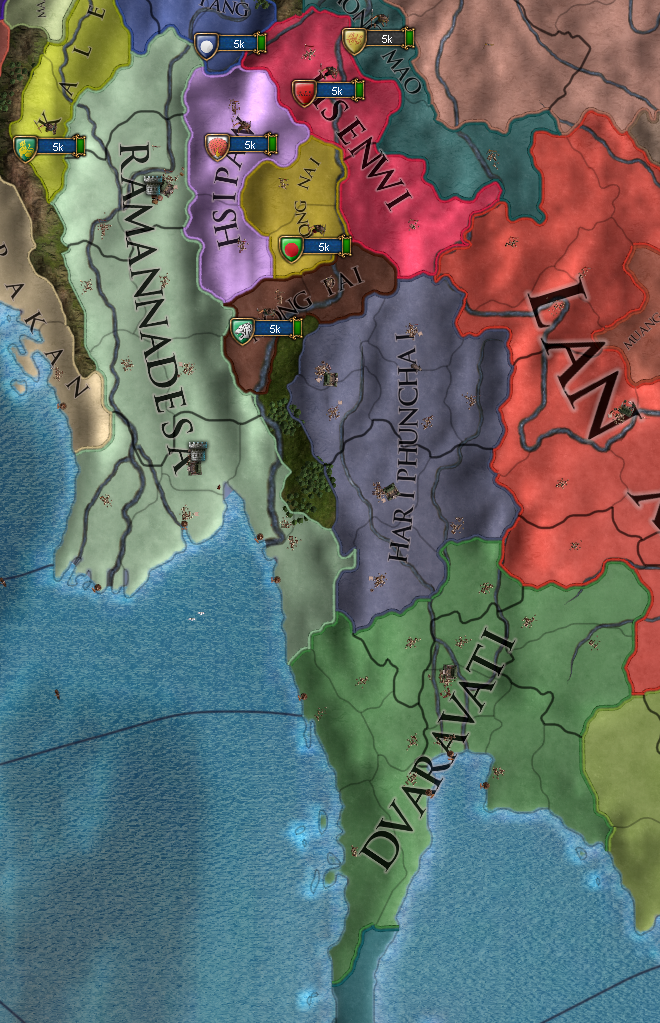
Restore the Mon hegemony in the South-East Asia update
Pegu is the last independent Mon kingdom at the start of the game, and besides a brief period of restoration in the 1700’s it would be the last sovereign Mon state ever to exist. The Mon people and culture were once the dominant force in what is now Myanmar and Thailand, but the Thai migrations and subsequent establishment of kingdoms such as Sukhothai, Lan Na, and Ayutthaya as well as the rise of Bamar kingdoms like Pagan and Ava forced the Mon to retreat to what is now Lower Burma. In 1444 Pegu is ruled by Binnya Ran, and he and his successors (including the celebrated Queen Shin Sawbu) would preside over Pegu’s golden age of peace and prosperity.
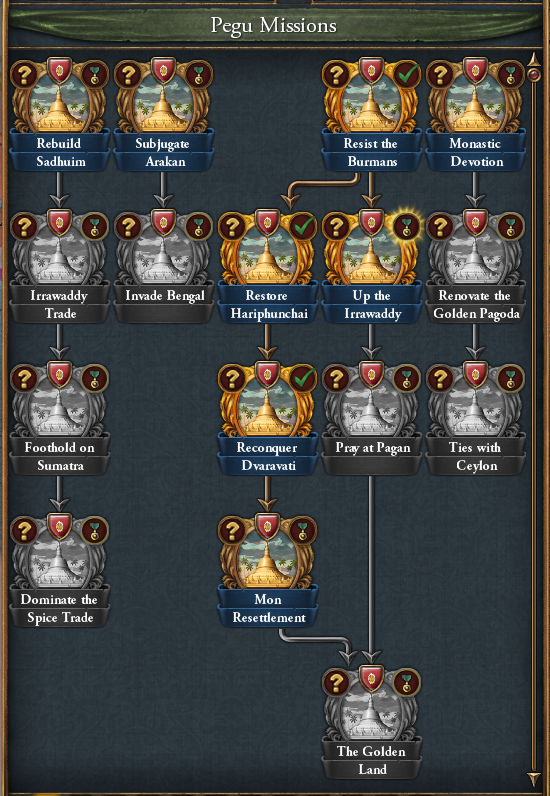
Binnya Ran and his heir Binnya Waru have had their monarch stats significantly increased. Their stats are now 3/5/4 and 4/2/3 respectively, making Pegu a stronger contender at the start of the game.
Some highlights from the Pegu mission tree:
Besides their mission tree, Pegu also receives a couple of new events that I’ll let speak for themselves:

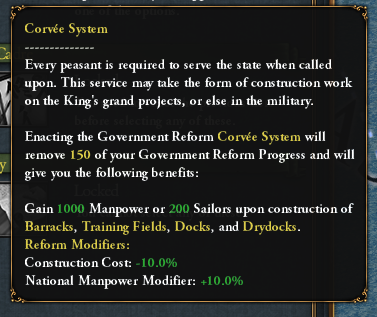
Since we’re talking about Pegu, the Sailor Mon achievement should be a little easier now: I’ve added a new tier 3 government reform available to all countries in the Thai, Burman, or Cambodian culture groups called Corvée System. This reform adds +10% National Manpower and -10% Construction cost, and also modifies your Docks and Barracks buildings so that they immediately grant 1000 manpower or 200 sailors upon completion.
Also somewhat relevant to Pegu is this:
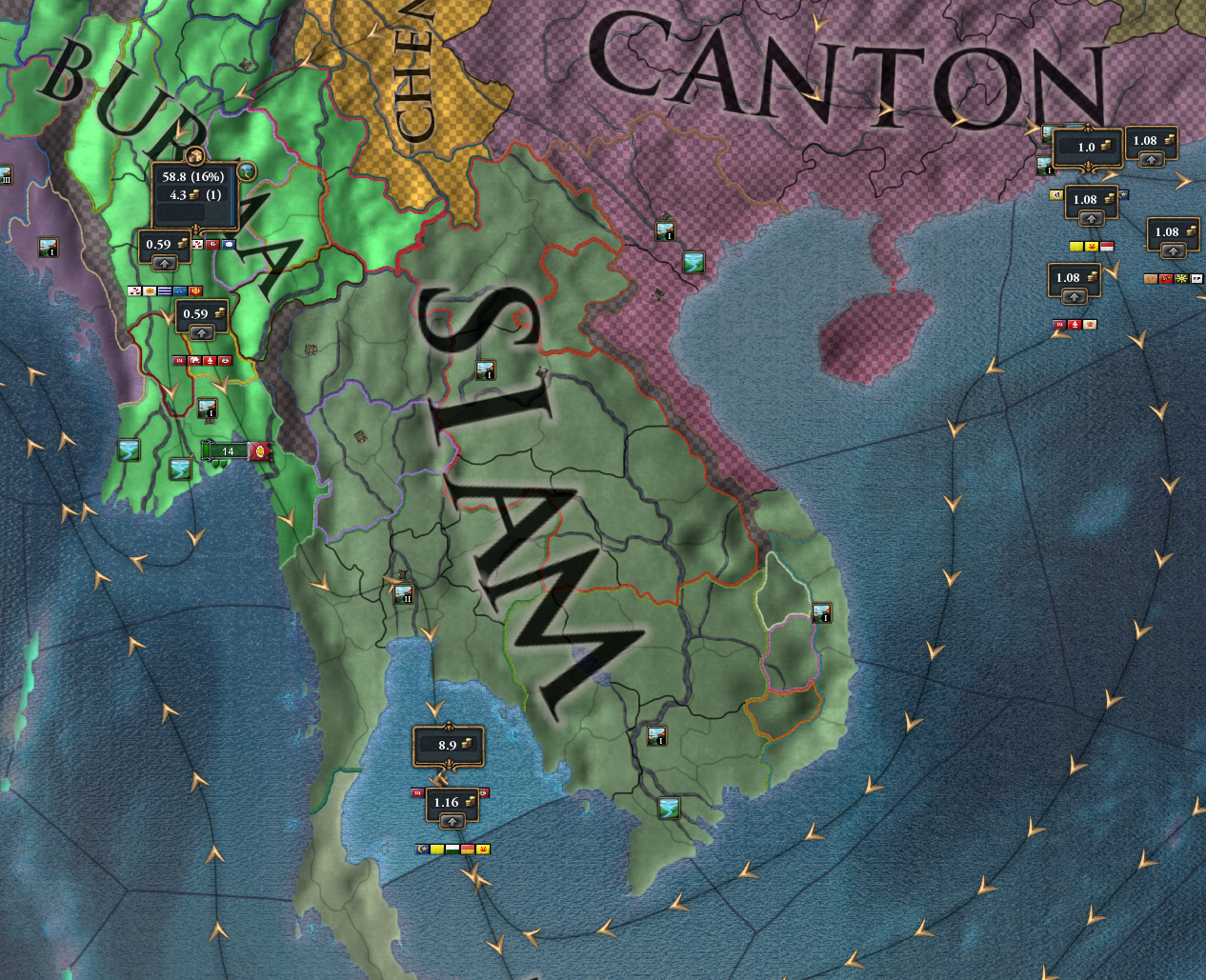
I’ve indicated before that I intended to revise the trade routes for the Siam node, and here it is. Now both Canton and Burma flow into Siam, while the Burma node is significantly improved with the addition of Lower Burma. Pegu will now have a much easier time dominating the Burma trade node, while players in the Siam node finally steer trade from China and Burma into their home node.
Next up, Lan Na:

In the South-East Asia update Lan Na will receive a small mission tree aimed primary at forming Siam, which requires owning Chiang Mai, Sukhothai, and Ayutthaya.
A Million Rice Fields unlocks the Advanced Irrigation estate privilege just like Khmer, giving -10% development cost in grain-producing provinces. Protect the Shrine refers to a minor but in my opinion pretty cool scripted mechanic called The Emerald Buddha:
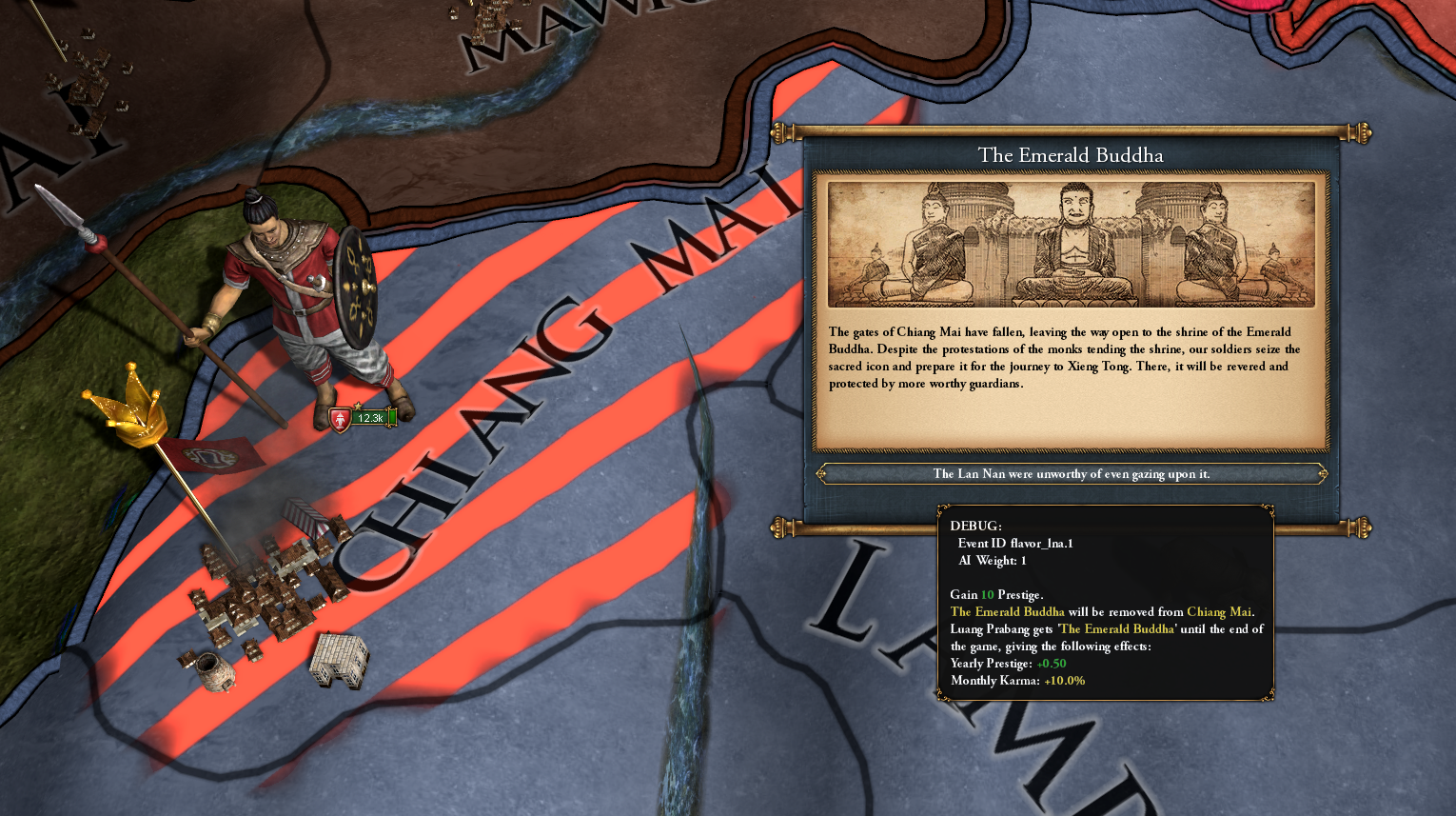
The Emerald Buddha functions as a permanent province modifier, initially present in Lan Na’s capital of Chiang Mai. This modifier provides your country with +0.1 Monthly Karma, and a decision is available to renovate the shrine for a cost and reverse the effect so that it instead provides -0.1 Monthly Karma depending on your current needs. You can switch the bonus back and forth endlessly so long as you can afford the cost. Historically the Emerald Buddha changed hands several times in our period, being appropriated by Lan Xang and eventually Ayutthaya. In EU4, any country in the Eastern religion group can seize the Emerald Buddha for themselves by occupying its present location. Losing control of the Buddha hits you with -20 Prestige and -10 Legitimacy, so you probably want to guard this sacred relic closely. This gives Buddhist players a new way to control their Karma and encourages competition over control of the Buddha.
Next up, Sukhothai:

Sukhothai receives only a very small set of missions, and like Lan Na’s missions they are essentially focused on acquiring the provinces you need to form Siam (and thereby get access to a much larger mission tree). But that’s not all for Sukhothai:
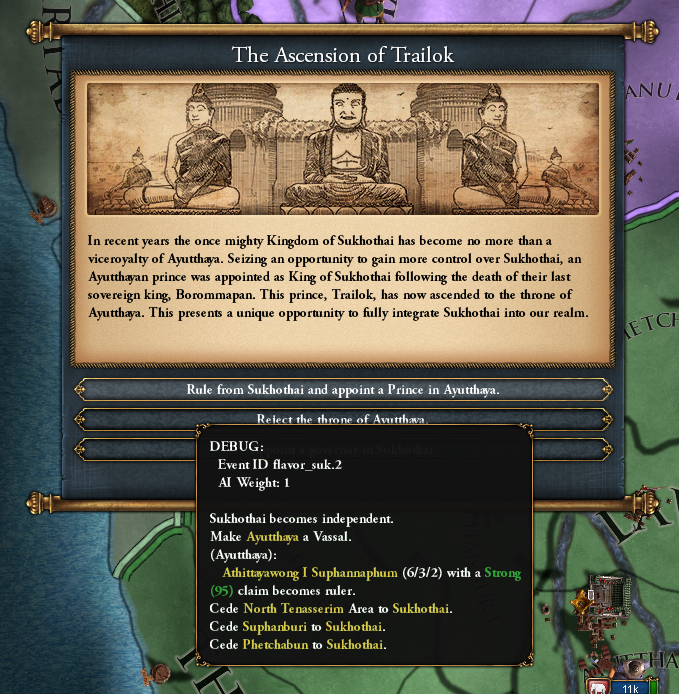
In 1444 the ruler of Sukhothai is Trailok, a prince of Ayyuthaya appointed as governor of the once-independent realm. Trailok would go on to become King of Ayutthaya, and this is now handled by and event in EU4. When Ayutthaya gets Trailok as its ruler, the above event fires and typically Ayutthaya will simply inherit Sukhothai. However, if Sukohthai is in player hands the event works very differently. The player can choose to make Ayutthaya into a vassal, separate from Ayutthaya entirely, or (the mechanically best option) make Ayutthaya into a vassal and gain control of the western part of their territory.
Now let’s look at the Shan states:
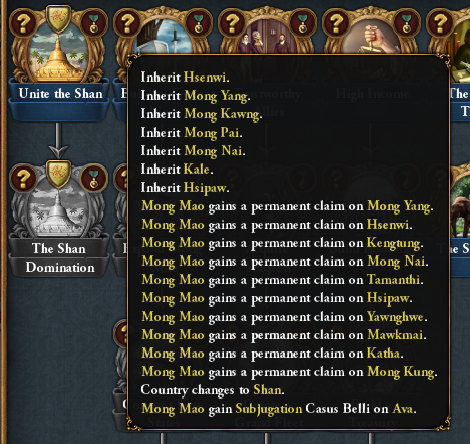
A colleague affectionately referred to the Shan missions as a “mission stick”. While it consists of only 2 missions, they pack a punch and can allow you to expand in a unique way. The first mission requires that all countries with Shan primary culture are either your ally or your vassal. Additionally, a total of 15 provinces must be owned by countries with Shan primary culture and you must have the largest army of all Shan-cultured countries. When you complete this mission, you immediately integrate all of the other Shan states and gain permanent claims on any Shan culture provinces that you do not own after the integration. You will also form the Shan tag and gain a Subjugation CB against Ava. This represents the formation of the Confederation of Shan States, led by Mong Yang, which banded together to defeat Ava in 1527. The Shan Domination mission requires subjugating or conquering Ava, and rewards permanent claims on all of Burma. Additionally, if Ava is your vassal at the time of completion it will change its primary culture to Shan and its ruler will be replaced by a prince of your dynasty. The Shan States can form Siam for access to their larger mission tree.
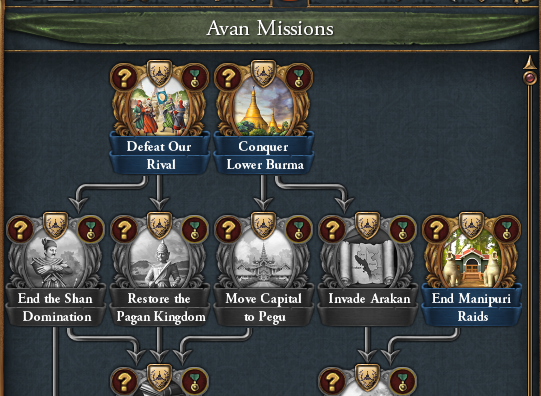
The Taungu mission tree has been slightly reworked so that it is now accessible to Ava and Prome as well as Taungu itself. This tree remains limited to owners of the Dharma expansion.
The Chakravarti mission from this tree has received a couple of notable additional rewards. It now gives you the option to switch to the new Chakravarti government reform discussed in previous dev diaries, as well as cosmetically changing the name of your nation to Burma.
Alright, last thing for today. I hope you’re up for an extreme challenge:
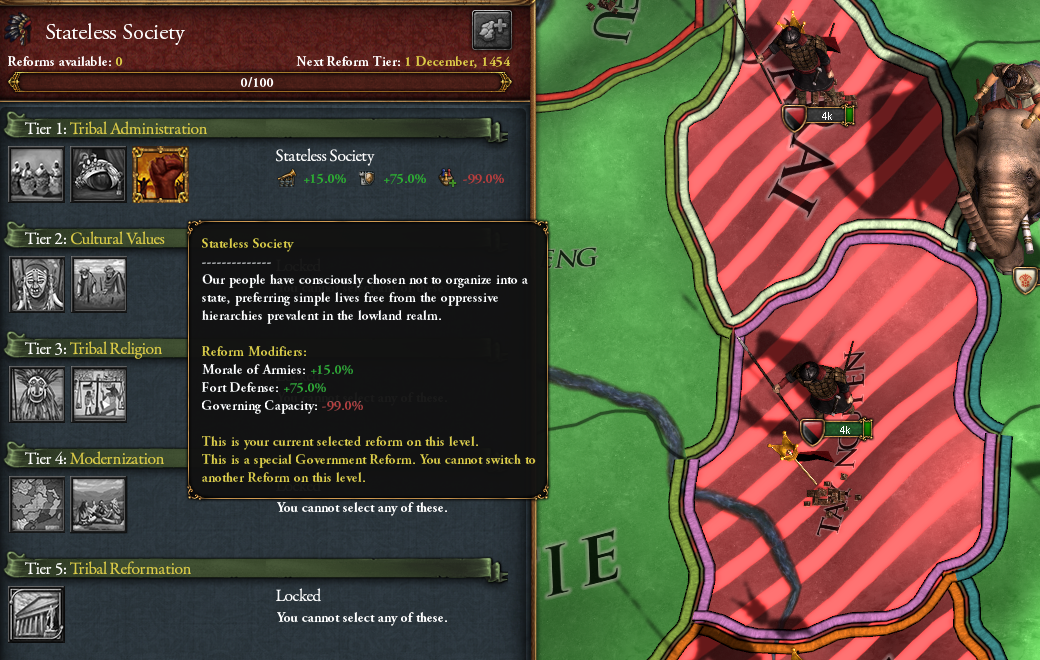
The highland tribes of Rhade, Jarai, and Koho begin with the Stateless Society reform. This gives them a massive 99% penalty to their governing capacity, making it almost impossible for them to expand. To make things worse, they are all Animist tribes that have not embraced feudalism and are not tributaries of Ming. Their only advantage is high starting morale and very defensible capitals. Play these tags if you fear nothing and love pain. Stateless Societies always reform into Peasant Republics.
That’s all for today! Next week will likely be the final South-East Asian content dev diary, so I’ll try to include as much of the content that I haven’t revealed yet as I can. That’s going to include a look at Lan Xang as well as a variety of nations in Maritime SEA like Sunda and Ternate. Until then, have a good week!
A word from PDX about the next patch
Good morning! Today’s dev diary will focus on Pegu but will also feature a variety of nations in Mainland South-East Asia - namely Lan Na, Sukhothai, the Shan states, the Burman nations, and the highland tribes.

Restore the Mon hegemony in the South-East Asia update
Pegu is the last independent Mon kingdom at the start of the game, and besides a brief period of restoration in the 1700’s it would be the last sovereign Mon state ever to exist. The Mon people and culture were once the dominant force in what is now Myanmar and Thailand, but the Thai migrations and subsequent establishment of kingdoms such as Sukhothai, Lan Na, and Ayutthaya as well as the rise of Bamar kingdoms like Pagan and Ava forced the Mon to retreat to what is now Lower Burma. In 1444 Pegu is ruled by Binnya Ran, and he and his successors (including the celebrated Queen Shin Sawbu) would preside over Pegu’s golden age of peace and prosperity.

Binnya Ran and his heir Binnya Waru have had their monarch stats significantly increased. Their stats are now 3/5/4 and 4/2/3 respectively, making Pegu a stronger contender at the start of the game.
Some highlights from the Pegu mission tree:
- The Rebuild Saghuin mission requires 20 development in both Pegu and Martaban. You will be rewarded with an upgrade to your Center of Trade in Pegu, while Martaban is renamed to Sahuin and given a permanent discount to its development cost.
- Further missions down this branch focus on gaining trade dominance in the Burma and Malacca nodes, rewarding Navy Tradition and Mercantilism along the way.
- Resist the Burmans requires that you own or vassalize Taungu and Prome, as well as have a larger army than Ava. This grants permanent claims on Ava as well as a Subjugation CB against Lan Na.
- The Restore Hariphunchai mission is where you make use of your CB against Lan Na. You must own or have a subject own all of the Chiang Mai area. If you complete this mission by vassalizing Lan Na, its primary culture will change to Mon and it will be renamed to Hariphunchai, an ancient Mon kingdom centered around modern Lamphun. You’ll also receive a Subjugation CB against Ayutthaya.
- Similarly to the mission above, Reconquer Dvaravati tasks you with conquering or subjugating Ayutthaya. If you do this by vassalizing Ayutthaya, its primary culture changes to Mon and its name changes to Dvaravati, an ancient civilization that spoke the Mon language. You will also receive a permanent -25% Culture Conversion Cost modifier that will help you with the next mission in this branch.
- The Mon Resettlement mission requires spreading the Mon culture to at least 30 owned provinces, restoring the ancient Mon cultural hegemony in the region. You’ll be rewarded with 50 Prestige and -10% Technology cost for the next 50 years.
- This mission tree has a variety of requirements and effects that I can’t talk about yet as they involve unrevealed code features that may or may not ultimately make it into the game.
- Completing the “final” mission - The Golden Land - gives the option of adopting the Chakravarti reform discussed in previous dev diaries, as well as changing your government rank to Empire and adding 100 of each Monarch Power. Your country will also be renamed to Ramannadesa, representing a shift from the Mandala system to a nation-state.
Besides their mission tree, Pegu also receives a couple of new events that I’ll let speak for themselves:


Since we’re talking about Pegu, the Sailor Mon achievement should be a little easier now: I’ve added a new tier 3 government reform available to all countries in the Thai, Burman, or Cambodian culture groups called Corvée System. This reform adds +10% National Manpower and -10% Construction cost, and also modifies your Docks and Barracks buildings so that they immediately grant 1000 manpower or 200 sailors upon completion.
Also somewhat relevant to Pegu is this:

I’ve indicated before that I intended to revise the trade routes for the Siam node, and here it is. Now both Canton and Burma flow into Siam, while the Burma node is significantly improved with the addition of Lower Burma. Pegu will now have a much easier time dominating the Burma trade node, while players in the Siam node finally steer trade from China and Burma into their home node.
Next up, Lan Na:

In the South-East Asia update Lan Na will receive a small mission tree aimed primary at forming Siam, which requires owning Chiang Mai, Sukhothai, and Ayutthaya.
A Million Rice Fields unlocks the Advanced Irrigation estate privilege just like Khmer, giving -10% development cost in grain-producing provinces. Protect the Shrine refers to a minor but in my opinion pretty cool scripted mechanic called The Emerald Buddha:

The Emerald Buddha functions as a permanent province modifier, initially present in Lan Na’s capital of Chiang Mai. This modifier provides your country with +0.1 Monthly Karma, and a decision is available to renovate the shrine for a cost and reverse the effect so that it instead provides -0.1 Monthly Karma depending on your current needs. You can switch the bonus back and forth endlessly so long as you can afford the cost. Historically the Emerald Buddha changed hands several times in our period, being appropriated by Lan Xang and eventually Ayutthaya. In EU4, any country in the Eastern religion group can seize the Emerald Buddha for themselves by occupying its present location. Losing control of the Buddha hits you with -20 Prestige and -10 Legitimacy, so you probably want to guard this sacred relic closely. This gives Buddhist players a new way to control their Karma and encourages competition over control of the Buddha.
Next up, Sukhothai:

Sukhothai receives only a very small set of missions, and like Lan Na’s missions they are essentially focused on acquiring the provinces you need to form Siam (and thereby get access to a much larger mission tree). But that’s not all for Sukhothai:

In 1444 the ruler of Sukhothai is Trailok, a prince of Ayyuthaya appointed as governor of the once-independent realm. Trailok would go on to become King of Ayutthaya, and this is now handled by and event in EU4. When Ayutthaya gets Trailok as its ruler, the above event fires and typically Ayutthaya will simply inherit Sukhothai. However, if Sukohthai is in player hands the event works very differently. The player can choose to make Ayutthaya into a vassal, separate from Ayutthaya entirely, or (the mechanically best option) make Ayutthaya into a vassal and gain control of the western part of their territory.
Now let’s look at the Shan states:

A colleague affectionately referred to the Shan missions as a “mission stick”. While it consists of only 2 missions, they pack a punch and can allow you to expand in a unique way. The first mission requires that all countries with Shan primary culture are either your ally or your vassal. Additionally, a total of 15 provinces must be owned by countries with Shan primary culture and you must have the largest army of all Shan-cultured countries. When you complete this mission, you immediately integrate all of the other Shan states and gain permanent claims on any Shan culture provinces that you do not own after the integration. You will also form the Shan tag and gain a Subjugation CB against Ava. This represents the formation of the Confederation of Shan States, led by Mong Yang, which banded together to defeat Ava in 1527. The Shan Domination mission requires subjugating or conquering Ava, and rewards permanent claims on all of Burma. Additionally, if Ava is your vassal at the time of completion it will change its primary culture to Shan and its ruler will be replaced by a prince of your dynasty. The Shan States can form Siam for access to their larger mission tree.

The Taungu mission tree has been slightly reworked so that it is now accessible to Ava and Prome as well as Taungu itself. This tree remains limited to owners of the Dharma expansion.
The Chakravarti mission from this tree has received a couple of notable additional rewards. It now gives you the option to switch to the new Chakravarti government reform discussed in previous dev diaries, as well as cosmetically changing the name of your nation to Burma.
Alright, last thing for today. I hope you’re up for an extreme challenge:

The highland tribes of Rhade, Jarai, and Koho begin with the Stateless Society reform. This gives them a massive 99% penalty to their governing capacity, making it almost impossible for them to expand. To make things worse, they are all Animist tribes that have not embraced feudalism and are not tributaries of Ming. Their only advantage is high starting morale and very defensible capitals. Play these tags if you fear nothing and love pain. Stateless Societies always reform into Peasant Republics.
That’s all for today! Next week will likely be the final South-East Asian content dev diary, so I’ll try to include as much of the content that I haven’t revealed yet as I can. That’s going to include a look at Lan Xang as well as a variety of nations in Maritime SEA like Sunda and Ternate. Until then, have a good week!





